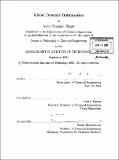| dc.contributor.advisor | Paul I. Barton. | en_US |
| dc.contributor.author | Singer, Adam B | en_US |
| dc.contributor.other | Massachusetts Institute of Technology. Dept. of Chemical Engineering. | en_US |
| dc.date.accessioned | 2005-09-27T17:35:10Z | |
| dc.date.available | 2005-09-27T17:35:10Z | |
| dc.date.copyright | 2004 | en_US |
| dc.date.issued | 2004 | en_US |
| dc.identifier.uri | http://hdl.handle.net/1721.1/28662 | |
| dc.description | Thesis (Ph. D.)--Massachusetts Institute of Technology, Dept. of Chemical Engineering, 2004. | en_US |
| dc.description | Includes bibliographical references (p. 247-256). | en_US |
| dc.description.abstract | (cont.) on a set composed of the Cartesian product between the parameter bounds and the state bounds. Furthermore, I show that the solution of the differential equations is affine in the parameters. Because the feasible set is convex pointwise in time, the standard result that a convex function composed with an affine function remains convex yields the desired result that the integrand is convex under composition. Additionally, methods are developed using interval arithmetic to derive the exact state bounds for the solution of a linear dynamic system. Given a nonzero tolerance, the method is rigorously shown to converge to the global solution in a finite time. An implementation is developed, and via a collection of case studies, the technique is shown to be very efficient in computing the global solutions. For problems with embedded nonlinear dynamic systems, the analysis requires a more sophisticated composition technique attributed to McCormick. McCormick's composition technique provides a method for computing a convex underestimator for for the integrand given an arbitrary nonlinear dynamic system provided that convex underestimators and concave overestimators can be given for the states. Because the states are known only implicitly via the solution of the nonlinear differential equations, deriving these convex underestimators and concave overestimators is a highly nontrivial task. Based on standard optimization results, outer approximation, the affine solution to linear dynamic systems, and differential inequalities, I present a novel method for constructing convex underestimators and concave overestimators for arbitrary nonlinear dynamic systems ... | en_US |
| dc.description.abstract | My thesis focuses on global optimization of nonconvex integral objective functions subject to parameter dependent ordinary differential equations. In particular, efficient, deterministic algorithms are developed for solving problems with both linear and nonlinear dynamics embedded. The techniques utilized for each problem classification are unified by an underlying composition principle transferring the nonconvexity of the embedded dynamics into the integral objective function. This composition, in conjunction with control parameterization, effectively transforms the problem into a finite dimensional optimization problem where the objective function is given implicitly via the solution of a dynamic system. A standard branch-and-bound algorithm is employed to converge to the global solution by systematically eliminating portions of the feasible space by solving an upper bounding problem and convex lower bounding problem at each node. The novel contributions of this work lie in the derivation and solution of these convex lower bounding relaxations. Separate algorithms exist for deriving convex relaxations for problems with linear dynamic systems embedded and problems with nonlinear dynamic systems embedded. However, the two techniques are unified by the method for relaxing the integral in the objective function. I show that integrating a pointwise in time convex relaxation of the original integrand yields a convex underestimator for the integral. Separate composition techniques, however, are required to derive relaxations for the integrand depending upon the nature of the embedded dynamics; each case is addressed separately. For problems with embedded linear dynamic systems, the nonconvex integrand is relaxed pointwise in time | en_US |
| dc.description.statementofresponsibility | by Adam Benjamin Singer. | en_US |
| dc.format.extent | 256 p. | en_US |
| dc.format.extent | 9893380 bytes | |
| dc.format.extent | 9927149 bytes | |
| dc.format.mimetype | application/pdf | |
| dc.format.mimetype | application/pdf | |
| dc.language.iso | en_US | |
| dc.publisher | Massachusetts Institute of Technology | en_US |
| dc.rights | M.I.T. theses are protected by copyright. They may be viewed from this source for any purpose, but reproduction or distribution in any format is prohibited without written permission. See provided URL for inquiries about permission. | en_US |
| dc.rights.uri | http://dspace.mit.edu/handle/1721.1/7582 | |
| dc.subject | Chemical Engineering. | en_US |
| dc.title | Global dynamic optimization | en_US |
| dc.type | Thesis | en_US |
| dc.description.degree | Ph.D. | en_US |
| dc.contributor.department | Massachusetts Institute of Technology. Department of Chemical Engineering | |
| dc.identifier.oclc | 58968295 | en_US |
